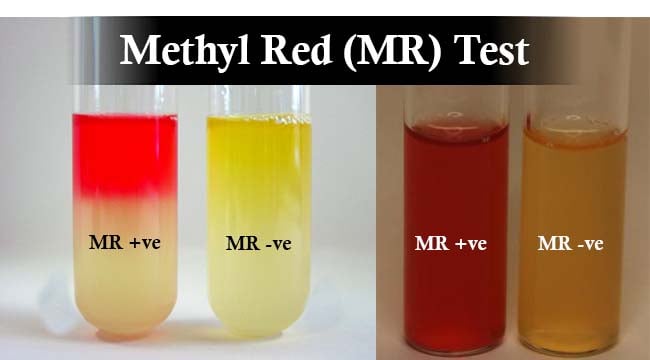Interesting Science Videos
Objectives of Methyl Red (MR) Test
- To differentiate two major types of facultative anaerobic enteric bacteria based on the production of acid.
- It identifies bacterial ability to produce stable acid end products by means of a mixed-acid fermentation of glucose.
Principle of Methyl Red (MR) Test
Methyl red test, commonly known as MR test is used to determine the ability of an organism to produce and maintain stable acid end products from glucose fermentation. MR test along with the VP test is performed simultaneously because they are physiologically related and are performed on MRVP broth. All members of the Enterobacteriaceae can convert glucose to pyruvic acid by the Embden-Meyerhof pathway, but bacteria can further metabolize pyruvic acid by two different pathways. Organisms metabolizing pyruvic acid by the mixed acid pathway will produce more acid end products, such as lactic acid and acetic acid, and maintain an acidic environment. The methyl red detects mixed acid fermentation that lowers the pH of the broth. The MR indicator is added after incubation which is red at pH 4.4 and yellow at pH 6.2. If the organism produces a large number of organic acids that include formic acid, acetic acid, lactic acid, and succinic acid from glucose fermentation, the broth medium will remain red after the addition of methyl red, a pH indicator. MR-negative organisms further metabolize the initial fermentation products by decarboxylation to produce neutral acetyl methylcarbinol (acetoin), which results in decreased acidity in the medium and raises the pH towards neutrality (pH 6.0 or above). For those organisms which do not produce the acid end products, the broth medium will change to yellow coloration indicating a negative test.
Media Used
MRVP broth
Buffered peptone 7.0 gm/L, Dextrose 5.0 gm/L, Dipotassium phosphate 5.0 gm/L, Final pH ( at 25°C) 6.9±0.2
Procedure of Methyl Red (MR) Test
- Inoculate MRVP broth with a pure culture of the organism.
- Incubate at 35°-37°C for a minimum of 48 hours in ambient air.
- Add 5 or 6 drops of methyl red reagent per 5 mL of broth.
- Observe for the color change in the broth medium.
Result Interpretation of Methyl Red (MR) Test

Positive: Bright red color
Weakly positive: Red-orange color.
Negative: Yellow color
Limitations of Methyl Red (MR) Test
- The MR test should not be read before 48 hours, because some organisms will not have produced enough products from the fermentation of glucose.
- MR-negative organisms may also not have had sufficient time to convert those products and will appear MR positive.
- If the methyl red test results are inconclusive (orange) after 48 hours, continue incubation of the broth for an additional three days and retest the broth culture.
- MR-VP testing should be used in conjunction with other confirmatory tests to differentiate organisms among the Enterobacteriaceae.
Quality Control of Methyl Red (MR) Test
MR positive: Escherichia coli (ATCC25922)
MR negative: Enterobacter aerogenes (ATCC13048)
References
- Tille P.M (2014)Bailey and Scott’s diagnostic microbiology, Thirteen edition, Mosby, Inc., an affiliate of Elsevier Inc., 3251 Riverport Lane, St. Louis, Missouri 63043
- Aneja K.R (2003), Experiments in Microbiology, Plant Pathology and Biotechnology, fourth revised edition, New Age International (P) limited, Ansari road, Daryaganj, New Delhi-110002.
- Barry AL, Bernsohn KL, Adams AB, Thrupp LD. Improved 18-hopur methyl red test. Appl Micro 1970; 20:866-70.
- Dalynn Biologicals (2002), Methly red reagent, catalogue no. RM65. http://www.dalynn.com/dyn/ck_assets/files/tech/RM65.pdf
